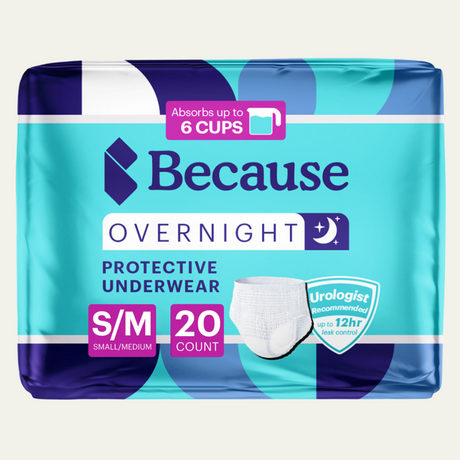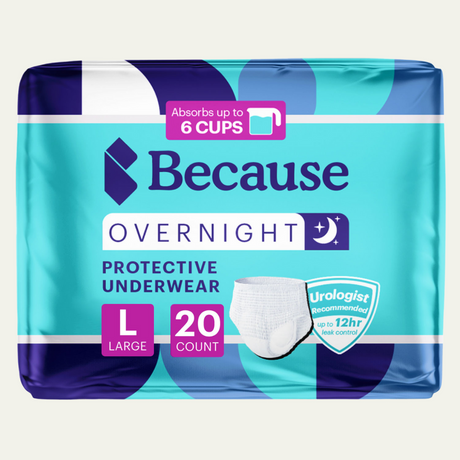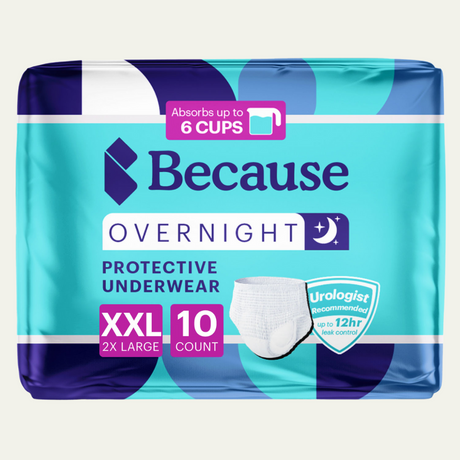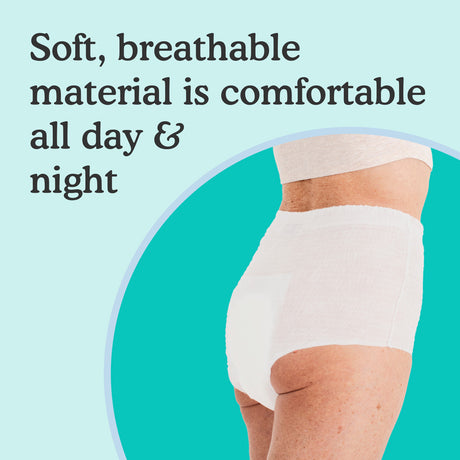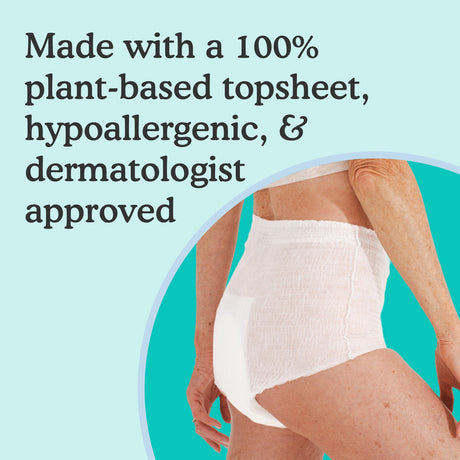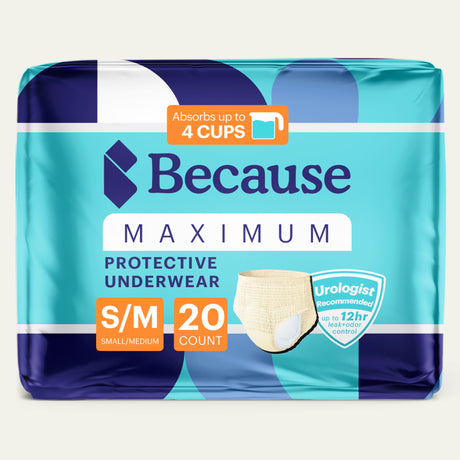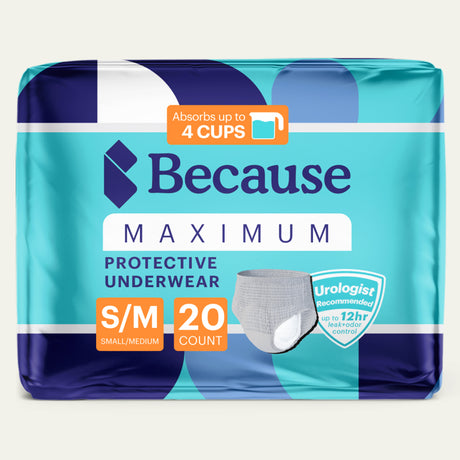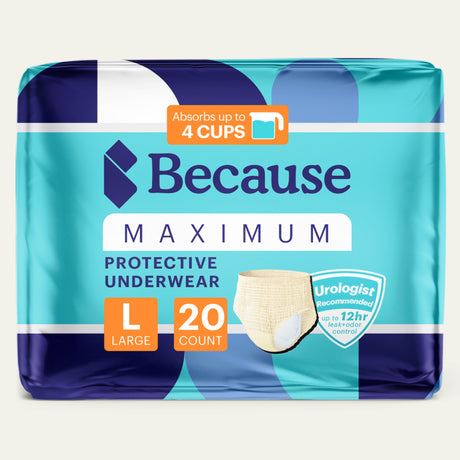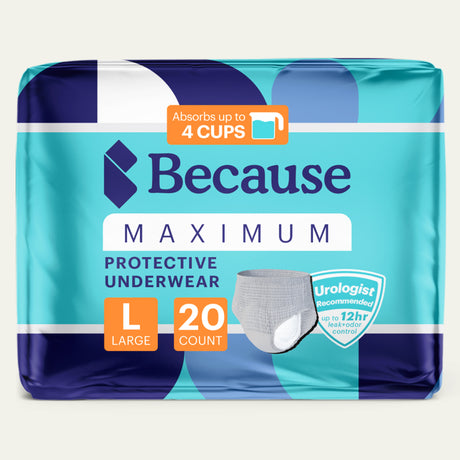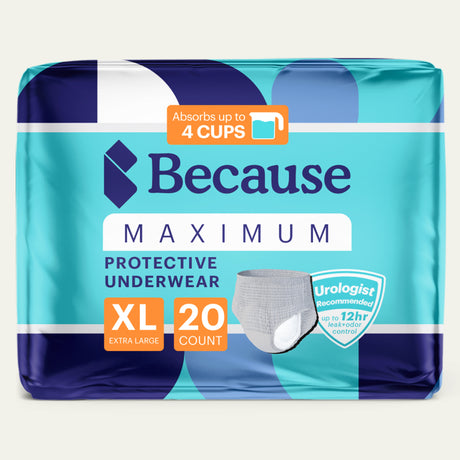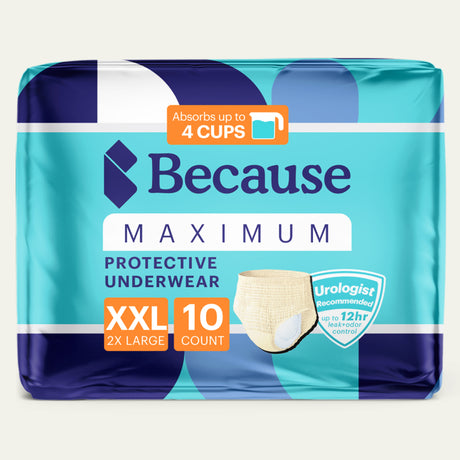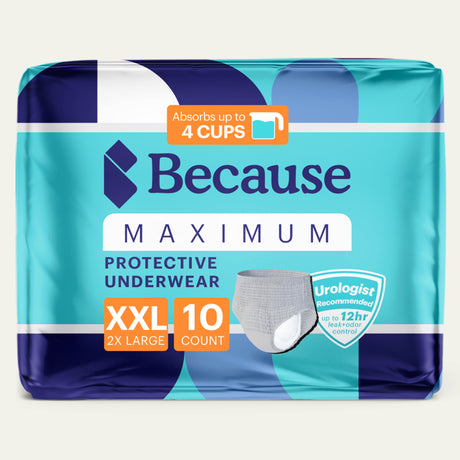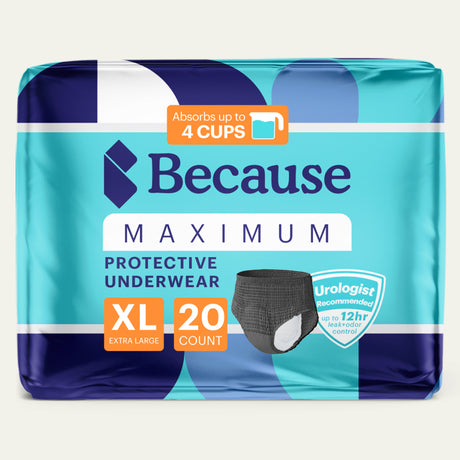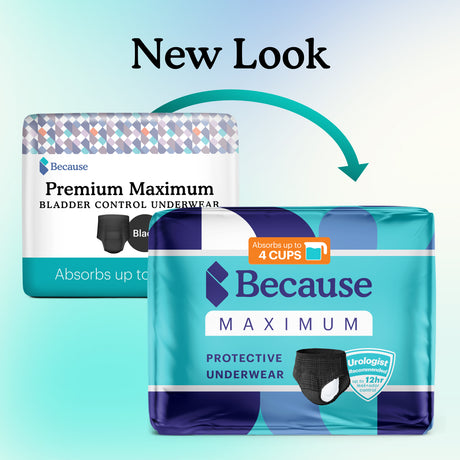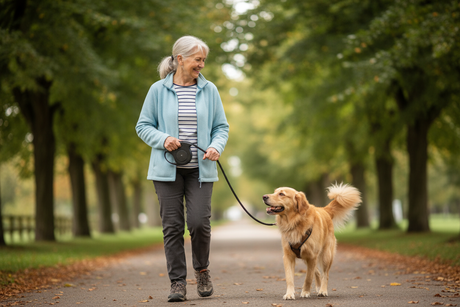While discussions about urinary incontinence often focus on women, that doesn’t mean men aren’t affected by incontinence. Although women are more likely to experience bladder leaks and accidents, an estimated 3 to 10% of men will develop urinary incontinence during their lives. The good news is that you can manage incontinence systems and enjoy a higher-quality life. Understanding what incontinence is, why it happens, and what you can do about are the first steps toward addressing symptoms.
What Is Male Incontinence?

Male incontinence most commonly refers to poor bladder control in men. However, the technical name for this type of incontinence is urinary incontinence. Urinary incontinence differs from fecal or bowel incontinence, which involves poor bowel control.
If you have male incontinence, you may experience urine leaks, dribbling, or a sudden intense urge to urinate, making it difficult to get to the bathroom in time.
Types of Male Incontinence and Their Potential Causes
The four main types of urinary incontinence that most commonly affect men include: stress incontinence, urge incontinence, overflow incontinence, and overactive bladder.
Stress Incontinence
Stress urinary incontinence (SUI) is when urine leakage happens with physical exertion. For example, you may experience bladder leakage when you cough, sneeze, or laugh. Intense physical activity like lifting heavy objects or exercising can cause spontaneous urination if you have SUI. This type of incontinence is the most common in older women but can also affect men.
The underlying cause of stress incontinence is a lack of support for the bladder. Without proper support, urine can leak out of the sphincter muscles that control urination. In women, this problem is often due to weakened pelvic floor muscles associated with childbirth or hormonal changes after menopause.
For men, other health problems usually lead to stress incontinence. Specifically, men with prostates removed to treat benign prostatic hyperplasia (enlarged prostate) or prostate cancer are most likely to develop the condition. In some cases, the urethra is damaged during prostate surgery, allowing urine to leak out of the urinary tract. In other patients, removing the prostate gland reduces the bladder’s support system, causing leaks. Stress incontinence due to radical prostatectomy is known as post-prostatectomy incontinence.
Urge Incontinence
Urge incontinence is a sudden urge to go to the bathroom. This urgent need to urinate happens due to bladder and nervous system problems. The bladder stores urine until it’s time for you to urinate. When it begins to get full, nerves send messages to the brain to tell you to go to the bathroom. Once you’re ready to go, your nervous system relays the message from your brain to your urinary system. Your bladder and sphincter muscles relax, which allows urine to travel through the urethra and out of your body.
If you have urge incontinence, your bladder contracts when it shouldn’t. Your brain interprets this as a strong need to urinate even if your bladder isn’t full.
Although we don’t fully understand the cause of urge incontinence, researchers have identified some potential risk factors for urinary urgency. They include:
- Bladder cancer
- Inflammation of the bladder
- Urinary retention or an inability to urinate caused by a blockage
- Bladder stones and kidney stones
- Urinary tract infections
- Brain and neurological conditions like stroke, multiple sclerosis (MS), and Parkinson’s disease
- Prostate problems
- Radiation therapy for cancer, though symptoms are usually short-term
- Spinal cord injuries and nerve damage
Overflow Incontinence
Overflow incontinence is when you feel the urge to urinate but can’t seem to go. Because your bladder doesn’t empty, you might experience dribbling that you can’t control.
Overflow incontinence occurs when something blocks or restricts the urine stream. When you urinate, only a tiny amount exits, so your bladder fills to the point where it can’t hold any more urine. The increased pressure forces the urine past the blockage.
In men, the most common cause of overflow incontinence is prostate enlargement. A narrow urethra and weakness of the bladder or pelvic floor muscles may also cause it.
Overactive Bladder
Overactive bladder (OAB) is a type of urge incontinence that occurs when the bladder spasms. Not everyone who develops an overactive bladder experiences a loss of bladder control. For some people, the condition causes frequent urination. Men who have OAB may also get up multiple times at night to urinate.
An enlarged prostate is usually the cause of OAB. When it becomes swollen, it puts pressure on the bladder and the urethra, leading to bladder problems. Because the risk for prostate enlargement increases with age, OAB is most likely to occur in older men. Nerve damage can also contribute to OAB in some cases.
Male Incontinence Treatment Options

Treatment options vary for different types of incontinence. The following are generally some of the most effective treatments for male incontinence — however, not all of them may be suitable for you. The best treatment for men depends on the type of incontinence, the severity of the symptoms, and factors such as other medical conditions.
First-Line Treatments
Often, doctors begin treatment for male incontinence with lifestyle changes and pelvic floor exercises. Men can reduce mild incontinence symptoms by avoiding foods and drinks that cause bladder irritation, regularly scheduling trips to the bathroom, and strengthening pelvic muscles.
Bladder Relaxant Medications
Healthcare providers may prescribe medication when symptoms are severe, or first-line treatments fail to address the incontinence. Alpha blockers like alfuzosin (Uroxatral), doxazosin (Cardura), silodosin (Rapaflo), and tamsulosin (Flomax) can reduce overflow symptoms and urge incontinence by relaxing the bladder muscles.
For overactive bladder, urologic care medical providers may recommend mirabegron (Myrbetriq) on its own or with another drug called solifenacin (Vesicare). The drug also relaxes the bladder muscles, but through a different method.
Treatment for Enlarged Prostate
If an enlarged prostate is the cause of male incontinence, doctors will likely treat the underlying condition to reduce urinary leakage, urgency, and other symptoms. Some treatments for benign prostatic hyperplasia (BPH) include:
- 5-alpha reductase inhibitors: Medications like dutasteride (Avodar) and finasteride (Proscar) shrink the prostate by preventing hormonal changes with age.
- Surgical procedures: A surgeon may remove some or all of the prostate gland using various techniques.
- Ablative therapy: This method uses lasers to remove tissue from the prostate so that urine can flow more easily.
- Prostatic urethral lift: A surgeon inserts tags that compress the prostate to increase urine flow.
Intermittent Self-Catheterization
For overflow incontinence, doctors may recommend intermittent self-catheterization. This option involves inserting a thin tube into your bladder through your urethra to drain urine into the toilet or drainage bags. There are a few different types of urinary catheters designed for home use. If your doctor prescribes this treatment, a medical provider will show you how to use the best type for you.
Injections
Injections are minimally invasive outpatient procedures that involve injecting substances into parts of the urinary tract with a needle. For stress incontinence, doctors may recommend Bulkamid, a water-based gel that increases the volume of the upper urethral sphincter. By strengthening and expanding the size of the muscle, Bulkamid enables the bladder to hold more urine.
Botox injections are another treatment for OAB. They involve injecting a small amount of botulinum toxin into the bladder. The injection reduces muscle spasms to ease incontinence symptoms.
Sling procedure
The sling procedure is a type of surgical support for the bladder. Doctors may treat stress incontinence by constructing a sling out of your body tissues, donor tissues, or mesh. Once the sling is in place, it lifts the bladder to minimize pressure.
Electrical Stimulation
Sacral nerve stimulation (SNS) is a treatment for bowel incontinence, urge incontinence, overactive bladder, and other forms of incontinence. It involves implanting a device that delivers mild electrical current to the nerves that control the bladder, colon, urethra, and pelvic floor muscles.
Artificial Urinary Sphincter
An artificial urinary sphincter is a cuff device your doctor implants inside your urethra. It attaches to a balloon placed in the belly muscles and a pump that typically goes into the scrotum. Once in place, the cuff inflates, preventing urine from flowing out. When you’re ready to urinate, you squeeze the pump to open the cuff.
Tips for Coping with Male Incontinence

Regardless of what kind of male incontinence you have, self-care can make the condition easier to manage, reduce the risk of complications, and potentially ease symptoms. Follow these tips to cope with male incontinence.
See a Doctor
Too often, men avoid seeking medical help for incontinence due to embarrassment or shame. Unfortunately, this prevents them from benefiting from male incontinence treatments. Urinary incontinence is a medical condition that affects many people, and you don’t need to feel embarrassed about discussing the issue with a healthcare professional.
Your medical provider is in the best position to diagnose you and recommend treatments and lifestyle changes. During an appointment, they’ll gather your medical history, discuss your symptoms, and perform a physical examination that may include a digital rectal exam to check your prostate. They may also order blood work or imaging tests to diagnose the problem.
After all test results are back, you and your healthcare provider can discuss the best male incontinence treatment options to reduce your symptoms.
Use the Right Bladder Protection Products
Bladder protection products help you stay dry throughout the day. Men have two main options to choose from: guards and incontinence underwear. Guards are a type of incontinence pad worn inside of your underwear, while underwear for a leaky bladder is worn instead of undergarments.
When choosing incontinence products for men, pay attention to absorbency levels. How much urine products can absorb before leaking varies. If you have only mild dribbling, mild to moderate absorbency products may be all you need. For more severe symptoms, look for maximum and overnight absorbency products.
Take Bladder Support Supplements
Bladder support supplements may reduce symptoms of incontinence for some men. Our Bladder Strength Daily Supplement contains soybean germ and pumpkin seed extract to support bladder muscles and improve control. In clinical studies, the supplement reduced urinary frequency, leaks, and urgency in just seven weeks.
Practice Good Incontinence Hygiene and Skin Care
Good hygiene is important for skin health and odor control. When you have an accident or experience bladder leakage, change your incontinence protection and clean up thoroughly with a no-rinse cleansing spray or cleaning wipes.
If you develop skin irritation, apply barrier cream to seal in moisture and limit your skin's contact with urine. For severe irritation, try moisturizing, soothing skin wipes.
Stay Hydrated
If male incontinence causes urinary frequency, reducing your intake of fluids may help. However, be careful not to overdo it. Dehydration can worsen incontinence by increasing urine concentration and raising the risk of bladder irritation. Your healthcare provider can suggest how much water you should consume daily to prevent dehydration while managing incontinence symptoms.
Avoid Foods and Beverages That Irritate the Bladder
Compounds in foods and beverages can end up in your urine, and some may cause irritation that worsens male incontinence. Bladder-irritating foods include tomatoes, citrus fruits, and spicy foods. Alcohol and caffeine drinks like coffee and soda may also trigger bladder inflammation.
Practice Pelvic Exercises
Pelvic exercises strengthen the muscles that support your bladder and may ease incontinence symptoms. Your doctor can show you targeted exercises or recommend a physical therapist to learn some.
Make a Bathroom Schedule
Making regular trips to the bathroom can reduce the risk of accidents. Even if you don’t have the urge to go, try to urinate at the same times during the day. Regularly scheduled bathroom trips can also be helpful for caregivers assisting older adults with incontinence.
Are you struggling to find the best bladder protection products for male incontinence? Take our bladder protection quiz and get a starter pack to try!
If you're struggling with incontinence, join our private support group today!
Men's Incontinence Support Group
Source:
Mayo Clinic Health System. (n.d.). Treatment Options for Men with Urinary Leakage. https://www.mayoclinichealthsystem.org/hometown-health/speaking-of-health/treatment-options-for-men-with-urinary-leakage


